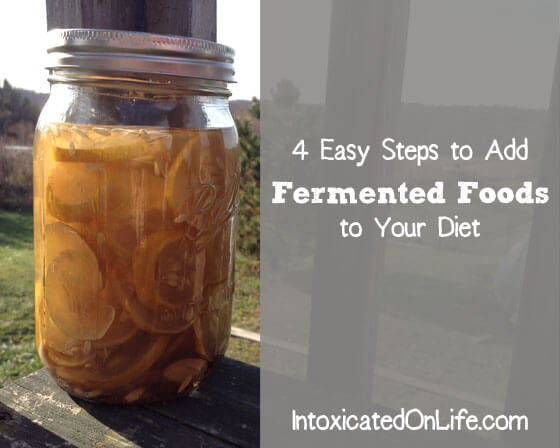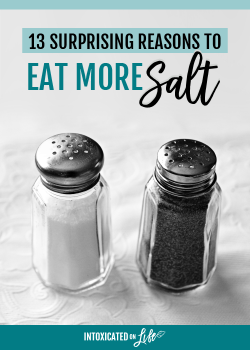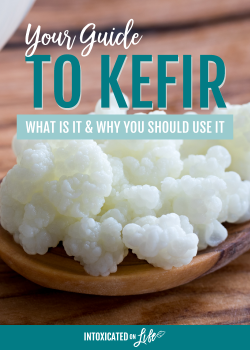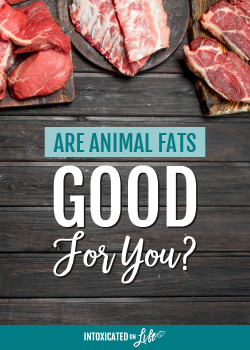Fermented foods are a traditional food that have slowly been phased out of the American diet for convenience. This is a shame because fermented foods contain probiotics to nourish your gut. They help aid your digestion and absorption of vitamins and minerals. Fermentation also increases certain vitamins and nutrients in foods.
Fermented foods are basically foods that have been preserved by a controlled exposure to bacteria or yeast. The bacteria breaks down sugars and carbohydrates and creates acids, gases, and/or alcohols that preserve the food for longer periods of time. Fermented dairy is usually referred to as cultured.
Sound scary?
Surprise! You’re Already Eating Some Fermented Foods!
Did you know that coffee, chocolate, cheese, yogurt, wine, and beer all go through fermentation? Not so scary now, is it?
Upgrade What You Already Eat
Our first easy step is to upgrade what you already use. For example, traditionally, foods like pickles and sauerkraut were made by fermenting. However, most commercial pickles and sauerkraut available today are simply preserved with vinegar. Vinegar is a fermented product, however when you process fermented foods with heat (like in the canning process), you kill any bacteria in it.
To upgrade your current pickled choices, look for foods that are lacto-fermented. One brand that carries lacto-fermented foods is Bubbies. Our family loves their dill pickles. They carry sauerkraut, relishes, and more.
Make Some Easy Substitutions
After you upgrade what you are already using, try making some simple substitutions. You can swap some standard diet staples for fermented or cultured foods by doing the following:
- Swap your high-fructose corn syrup laden sodas for probiotic-rich kombucha, a fermented tea product that has a fizz to it.
- Instead of using regular bread for your sandwiches and toast, try a quality sourdough.
- Do you have a butter lover in your household? Switch your regular butter for a rich, cultured butter.
One of our family’s favorite snacks is a piece of sourdough bread with cultured butter. And even our kids like kombucha.
Stepping Out of the Comfortable Box
The third step involves a little stretching, but stretching is good for you. You’ve upgraded your current ferments to lacto-ferments and swapped out some unhealthy things for healthier options. Now we are going to try some new things. And we are going to do with a little game of If, Then.
- If you like yogurt, then try kefir.
- If you like sauerkraut, then try kimchi or chow chow.
- If you like dill pickles, then try some fermented veggies like green beans or carrots.
- If you like salsa, then try fermented salsa.
Ease the Budget Burden
Easy step number four is to help ease the budget strain you may be feeling by purchasing fermented foods. Buying properly fermented foods can get expensive. The antidote for this is making them yourself. Fermentation is relatively easy, but can seem overwhelming.
Start where you are. Look at what you have ready access to. If you have access to fresh raw milk inexpensively, start with the cultured dairy products your family uses most. If you have an abundance of produce, start fermenting them in small batches. Do you eat a lot of bread, but can’t afford to buy good sourdough for all of it? Consider purchasing a sourdough starter kit and making your own.
Why did I make this the last step instead of the first to keep it cheap from the get-go? Two reasons. One, often the thought of trying to add something new to your life is overwhelming. I did not want to add two new things (the food and the process of creating it) at once. Second, you may not like everything you try. You will get a better feel for whether you like a fermented product if you know what it is “supposed” to taste like verses wondering if you messed something up in the process. Ask me how I know.
It’s All About Habit
You can take the easy steps to gradually increase the amount of fermented foods in your diet in this post, but it all comes down to habit. Don’t try to do this all at once, it likely will not stick. Take it one step at a time. You want this to build life-long, health-building habits for you and your family. Slow and steady wins the race. Get my point?







I have Chow Chow. It is okay. I have a problem with fermented foods. I wish I could like them, but I really do not. Until I grow up a bit and get brave, probiotics it is for me!! This week, I am multitasking. The kids love the Elf on the Shelf, and I have a blog to keep up, so our elf is teaching us all kinds of lessons about essential oils, weight loss, and more. I hope you will check it out @ My lamp is full.
I can relate. My kids and husband are so much better about trying and liking fermented foods. I had never heard of chow chow until I married my husband.
Love this! Vicki, I didn’t know this about you! 🙂 I’ll be sharing fo’ sho!
Healing from Dairy Allergies – Why You Don’t Have to Live Dairy-free (http://growinguptriplets.com/2013/12/18/healing-from-dairy-allergies-dont-have-live-dairy-free/)
Thanks, Jennifer! 🙂
very good blog. great information, and well-written. i’m looking into add fermented foods into my diet, so this post was a good place to start.